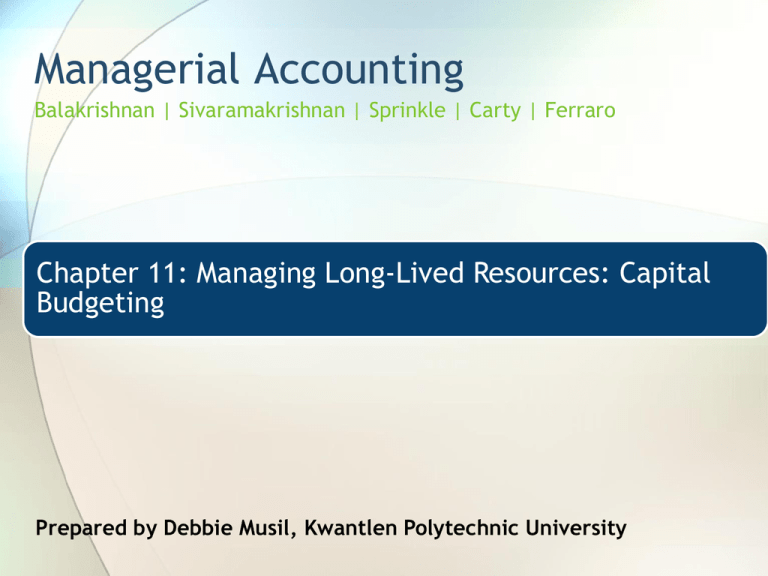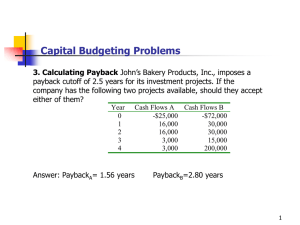
Managerial Accounting
Balakrishnan | Sivaramakrishnan | Sprinkle | Carty | Ferraro
Chapter 11: Managing Long-Lived Resources: Capital
Budgeting
Prepared by Debbie Musil, Kwantlen Polytechnic University
What is Capital Budgeting?
• Significant investments take place
because of many factors
− As time passes, assets wear out and must be
replaced
− Growth in demand has overtaken available
capacity
− Launching new products / market expansion
− Changing production technology
LO1: Understand the reasons for capital budgeting
What is Capital Budgeting?
• Such project decisions have two main
components
− Evaluate Project profitability
− Allocate scarce capital among profitable projects
• Capital budgeting refers to the set of tools
used to evaluate such large expenditures
• Let us begin by linking to two familiar topics
− Cost allocations and budgets
LO1: Understand the reasons for capital budgeting
Link to Cost Allocations
• Both allocations and capital budgeting
deal with capacity decisions
• However, allocations suffer from two
main drawbacks: they do not consider:
− Time value of money
− Lumpy nature of capacity
LO1: Understand the reasons for capital budgeting
Defects: Cost Allocations
• Time value of money
− $1 today is worth more than $1 a year from today!
− Capital assets last for many years. Thus, we need to
consider time value for effective decision making
• In capital budgeting, we discount future cash flows to their
present value so that we can consider projects with
alternate cash flow patterns
• Lumpy nature of capacity
− Capacity resources come in discrete sizes
• Allocations assume “smooth” capacity.
• That is, they allow for capacity to be bought in small
increments. But, we cannot buy 15/16th of a machine.
− Capital budgets explicitly recognize lumpy capacity
LO1: Understand the reasons for capital budgeting
Link To Budgets
• Capital budgets link strategic plans and
operating budgets
• Strategic plans
− Set the vision for the future
− Flesh out core competencies
• Operating budgets (chapter 7)
− Deal with the here and now
− Take capacity resources more or less as a given
• Capital budgets consider both needs as
dictated by operating budgets and plans as
dictated strategically
LO1: Understand the reasons for capital budgeting
Steps in Capital Budgeting
• Identify and evaluate individual proposals
(“screening decisions”)
− Proposed by management as well as others
• Dictated by strategic visions
• Prioritizes proposals and decide which to fund
(“preference decisions”)
− Ability to fund projects limited by capital /
managerial talent
− Fit with strategic profile varies
− Qualitative dimensions (e.g., safety, environment)
might dominate choice
LO1: Understand the reasons for capital budgeting
Elements of Cash Flow for Projects
• Initial Outlay.
− What are the costs associated with acquiring the resource and
getting it ready for use?
• Estimated Life and Salvage Value.
− How long do we expect to keep the resource?
− At the end of this period, what is the cash flow associated with
selling / disposing off the resource?
• Timing and Amounts of Operating Cash Flows.
− What are the expected operating expenses every year?
− What are the expected revenues?
• Cost of Capital.
− What is the opportunity cost of capital required for the proposed
investment?
LO2: List the components of a project’s cash flows
Timeline: Project Cash Flow
LO2: List the components of a project’s cash flows
Cash Flows for MRI Machine
LO2: List the components of a project’s cash flows
Timeline for MRI Machine Cash Flow
How should we evaluate whether
this is a profitable investment?
LO2: List the components of a project’s cash flows
Many Ways To Evaluate Profitability
LO3: Apply discounted cash flow techniques
1
2
3
4
1 $62.10 = $100 × 0.621
2 $152.10 = $100 × 1.521
3 $331.20 = $100 × 3.312
4 $811.50 = $100 × 8.115
Net Present Value (NPV)
• NPV is present value of ALL cash flows
• PV of cash flow in period t =
− “r” is the discount rate
− 1/(1+r)t is the discount factor
• The net present value is the sum of all of
the present values of the individual cash
flows
− NPV recognizes a lump sum outflow at the start
− Periodic inflows over the life of the project
− Salvage value
LO3: Apply discounted cash flow techniques
NPV of Project
This is a profitable project.
LO3: Apply discounted cash flow techniques
Sensitivity analysis
• Can vary discount rates to reflect differing
evaluations of risk associated with the project
• Can also calculate NPV for alternate scenarios
− Lower price to increase demand early on
• Benefit: Higher revenue with greater present value
• Cost: Lower revenue later on (but PV impact is also smaller)
− Usage rates
− Life of asset
• Such extensions are important because we need
to make many assumptions to estimate the cash
flow from this long-lived asset
LO3: Apply discounted cash flow techniques
High Discount Rates Lower NPV
LO3: Apply discounted cash flow techniques
$52,620
0.877
-$100,000
0.769
$38,450
0.675
$6,750
Thus, the NPV = $6,750 + $38,450 + $52,620 – $100,000 = -$2,180.
We reject the project because it has a negative NPV.
Assumptions in NPV Analysis
• The initial cash outflow takes place at the beginning
of the period.
− This is the reason for not discounting the initial outlay
• Subsequent cash inflows and outflows occur at the
end of the relevant period.
− The net cash flow in year 1 occurs as a lump sum at the
end of year 1, which is time t =1, or a year from time t =
0
• NPV calculations assume that firms reinvest future
cash inflows in projects that yield a return that
equals the cost of capital
• None of these assumptions are particularly realistic
but they are not unreasonable
LO3: Apply discounted cash flow techniques
Internal Rate of Return
• Discount rate at which the NPV is zero
• Relation to NPV analysis
− NPV analysis fixes the discount rate and
calculates the present value
− IRR fixes the NPV at zero and calculates the
implied rate
• Project evaluation criterion
− NPV > 0 => project return exceeds cost of
capital
− IRR > Cost of capital => project has positive
NPV
LO3: Apply discounted cash flow techniques
Calculating IRR: Unequal Flows
• This can be mathematically challenging
• It is much more convenient to use a
program such as EXCEL.
− @IRR(A1..A10) function gives the IRR for a
set of cash flows in cells A1 to A10
− Remember to keep the signs consistent
• The IRR for the project is 20.87%
• This is a highly profitable project because
the IRR exceeds the cost of capital of 12%
LO3: Apply discounted cash flow techniques
Calculating IRR: Equal flows
• This is like an annuity
• Use annuity tables to find annuity Factor
• For a given project life, find rate that has
the relevant annuity factor
• Example: Initial investment $50,000,
$15,000 inflow for 5 years
− Annuity factor = $50,000 / $15,000 = 3.33
− Looking down column for 5 periods, the rate
is between 15% and 16%
LO3: Apply discounted cash flow techniques
Assumptions: IRR
• Timing of cash flows
− Same as NPV Analysis
• Initial outflow now at start of period
• Inflows at end of period
• Reinvestment
− Takes place at the calculated IRR
− This is not a good assumption, particularly for
projects with high IRR
• It is possible to construct examples where
the same project has multiple IRRs
− Needs unusual cash flow patterns
LO3: Apply discounted cash flow techniques
Comparing NPV and IRR
• Many people prefer NPV to IRR
− Unique answer for NPV
− Reinvestment assumption is more reasonable for
NPV than IRR
• We are more likely to have projects that return the
cost of capital than return a high IRR
− NPV favors larger projects with greater absolute
profit while IRR focuses on profitability without
concern for size
• Both methods have value
− Firms try to rank order projects by both methods
− Unfortunately, the above differences mean that
sometimes the rank ordering of projects may not
be the same
LO3: Apply discounted cash flow techniques
In Excel, enter cash flows in cells A1 to A4
(starting with the –$100,000 for the initial
outlay in A1).
In cell A5, type “=IRR(A1:A4)” and Excel
will reveal that the IRR = 12.40%.
Using the same approach as in Check it!
Exercise #2, we can calculate NPV(12%) =
$550; NPV(13%) = -$820, and confirm the
validity of our estimate. Finally, we reject
the project because its IRR is lower than
the cost of capital (14%).
The
Result
Payback Method
• Payback period is the length of time it
takes to recoup the initial investment
• Initial out flow of $60,000 and periodic
inflows of $24,000
• Payback period = 2.4 years =
$60,000/$24,000.
LO4: Compare various methods for evaluating projects.
Evaluating Payback Method
• Advantages
− It is a simple easy method
− Focuses on the downside risk
• But…
− Ignores the time value of money
− Ignores cash flows that occur after the
payback period
− Not enough emphasis on upside potential
• Acceptable payback period is unclear
LO4: Compare various methods for evaluating projects.
Payback Period for Project
LO4: Compare various methods for evaluating projects.
Cumulative cash inflows through year 5 =
$60,000 year 1
+ $60,000 year 2
+ $60,000 year 3
+ $50,000 year 4
+ $50,000 year 5
= $280,000
Payback period of 5.6 =
5 years + ($310,000 initial investment – $280,000 cumulative
cash inflows through year 5)/$50,000 cash flow in year 6.
Modified Payback
• Calculates the payback period using discounted
cash flows
• Overcomes a major defect of the payback period
• But, it still does not account for cash flows after
the modified payback period
• Overall,
− Payback and modified payback can provide some
measure of risk in project
− But, they are not preferred because of their
shortcomings
− Use as a secondary criterion rather than as the main
rule
LO4: Compare various methods for evaluating projects.
Modified Payback
LO4: Compare various methods for evaluating projects.
Accounting Rate of Return
AR
R
=
Average annual income from the project
Average annual investment
• Annual income = Annual cash flow – depreciation
• Investment = Average book value at start & end of period
• For project:
− Depreciate using the straight-line method and assuming zero salvage
value
− First, we decrease the book value of the equipment by the
depreciation amount
− We then calculate the average investment balance for each year as
the average of the beginning and ending book values
− The final step is to compute ARR as the ratio of the average income
to the average investment over the lifespan of the investment.
LO4: Compare various methods for evaluating projects.
ARR Calculations
LO4: Compare various methods for evaluating projects.
ARR: Evaluation
• Easy and straight forward to calculate
• Ties in well with standard “accounting”
measures of performance
• Ignores time value of money
• Ignores patterns of cash flow
− Most suited for simple projects with
somewhat equal cash flows over the life of
the project
LO4: Compare various methods for evaluating projects.
Comparing the Methods
Feature of Method
Net
Present
Value
Considers time value of
money
Yes
Yes
No
Yes
No
Considers all cash flows
Yes
Yes
No
No
No
Return earned on
invested cash inflows
Cost of capital
IRR
Ease of computations
Moderate
Moderate
to difficult
Easy
Easy to
moderate
Easy to moderate
No
No
Yes
Yes
No
No
No
No
No
Yes
Greater focus on
avoiding losses than on
making profit
Integrates well with
accounting performance
measures
Internal
Modified
Rate of Payback
Payback
Return
Not
Not
applicable applicable
Accounting
Rate of
Return
Not applicable
LO4: Compare various methods for evaluating projects.
Usage Patterns
Often or
Always
Sometimes
Rarely or
Never
NPV
85.1%
10.9%
4.0%
IRR
76.7
15.4
7.9
Payback
52.6
21.9
25.5
Modified Payback
37.6
19.1
43.3
ARR
14.7
18.6
66.7
Source: P.A. Ryan and G. P. Ryan, Capital Budgeting Practices of the Fortune 1000: How have Things
Changed? Journal of Business and Management, Volume 8 (4), 2002.
LO4: Compare various methods for evaluating projects.
The Effect of Taxes
• We can depreciate the cost of a capital
asset over time
− Accounting income = Operating cash flow
less other non-cash items less depreciation
− We focus on the effect of depreciation
• Taxes are paid on accounting income,
NOT cash flow
− Depreciation lowers income and thus taxes
− Provides a tax shield
LO5: Explain the role of taxes and depreciation tax shields.
Calculating the Tax Shield
• Method 1:
− Depreciation tax shield = tax rate × depreciation
− Tax on operating cash flow = t × operating cash
flow
− After-tax cash flow = (1-t) × operating cash flow
+ depreciation tax shield
• Method 2 (Same answer as method 1):
− Calculate Income = Cash flow – depreciation
− Calculate taxes = t × income
− After-tax cash flow = (1-t) × income +
depreciation
LO5: Explain the role of taxes and depreciation tax shields.
Salvage Value and Taxes
• Need to pay taxes on any gain or loss due
to disposal of asset
− Gain/ loss may arise because accounting
depreciation is not always the same as
decline in economic value
• Calculation
− Gain or loss = sale proceeds – Net Book Value
− Net Book Value = Initial investment –
accumulated depreciation
− Note: Tax is paid on the gain / loss and NOT
on the proceeds
LO5: Explain the role of taxes and depreciation tax shields.
$304,000 in year 5 = $370,000 net cash inflow from Exhibit 11.2 –
[($370,000 – $150,000 depreciation expense) x 0.30 in taxes due].
Alternatively, $370,000 – $150,000 = $220,000 in taxable income;
$220,000 x 0.30 = $66,000 in taxes.
Thus, $304,000 = $220,000 in income – $66,000 in taxes + $150,000
in depreciation expense. $346,000 in year 10 = $430,000 net cash
inflow from Exhibit 11.2 – [($430,000 – $150,000 depreciation
expense) x 0.30 in taxes due].
Uncertainty
• Two approaches to cash flow uncertainty:
− Consider a few scenarios using high, medium and
low estimates of revenues or savings
− Do a breakeven calculation on how much annual
cash flows must be in order to have an NPV = 0
• Two approaches to uncertain project life:
− Consider a few scenarios using shorter lives to
determine hw long it takes before NPV = 0
− Do a “discounted payback” calculation to
determine how long it takes for project to pay
for itself
Allocating Capital Among
Projects
• Most firms have limited access to capital,
managerial talent, and other
organizational resources
− Use hurdle rate to select projects
• Hurdle rate > Cost of capital. Why?
− Risk inherent in estimation process
− Reduce slack built into budgets
− Force managers to come up with “best”
projects
LO6: Describe issues in allocating scarce capital among projects
Non-financial Costs and
Benefits
• Many benefits are hard to assess
− Environmental impact
− Worker / consumer safety
− Quality of products (image in marketplace)
• Costs can be difficult as well
− Training
− On-going maintenance
− Effect on other products
• The benchmark is usually the status quo
− But, difficult to evaluate cash flow under status
quo
LO6: Describe issues in allocating scarce capital among projects
Pick The Right Benchmark
LO6: Describe issues in allocating scarce capital among projects
Flexibility
• All projects involve some degree of
uncertainty
• Some projects inherently have more
flexibility than others
− Smaller upfront commitment (“dipping toe in
water”)
− These projects let firms adjust more rapidly to
any new information they may obtain
• Such flexibility (or the option to change
one’s mind) has value
− Usually called a “real” option
LO6: Describe issues in allocating scarce capital among projects
Real Option Analysis
Value of Flexibility
LO6: Describe issues in allocating scarce capital among projects
Exercise 11.31
Present value calculations (LO3).
Refer to the data in the following table:
Setting
Initial outlay
1
Life
Discount rate
Future value
(years)
(compounded
annually)
(at the end of life)
$225,000
5
10%
?
2
?
10
12%
$400,000
3
$157,950
8
?
450,000
4
$150,000
?
12%
$371,400
Required:
Treating each row of the table independently, compute the
missing information. Use the present value/future value
tables in Appendix B.
Exercise 11.31 (Continued)
Treating each row of the table independently, compute the missing information.
Use the present value/future value tables at the end of the book.
For each setting, we use the appropriate present value factors from
the tables in Appendix B. The relevant table and the factor are given
in parentheses for each setting.
Setting
Initial outlay
1
2
Life
Discount rate
Future value
(years)
(compounded
annually)
$225,000
5
10%
$128,800
10
12%
$400,000
(Table 1: Factor 0.322)
(at the end of life)
$362,475
(Table 2: Factor 1.611)
3
$157,950
8
14%
450,000
4
$150,000
8
12%
$371,400
Copyright
Copyright © 2011 John Wiley & Sons Canada, Ltd. All rights reserved.
Reproduction or translation of this work beyond that permitted by
Access Copyright (the Canadian copyright licensing agency) is unlawful.
Requests for further information should be addressed to the
Permissions Department, John Wiley & Sons Canada, Ltd. The purchaser
may make back-up copies for his or her own use only and not for
distribution or resale. The author and the publisher assume no
responsibility for errors, omissions, or damages caused by the use of
these files or programs or from the use of the information contained
herein.









